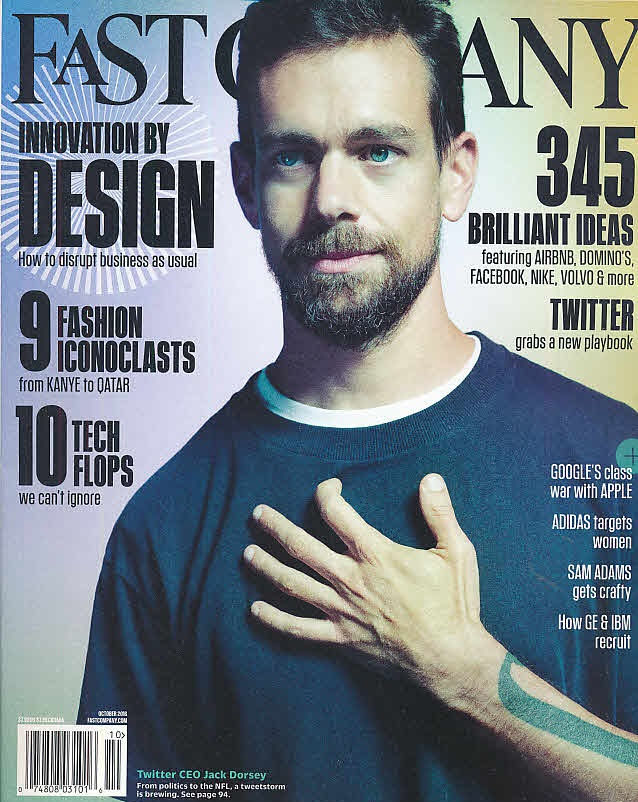 |
Secret Giant of DNA Sequencing
Fast Company | September 2016 Massimo became one of the first patients in the world to have his genome sequenced by Illumina’s machines, followed by his parents. The rationale seemed simple enough: His parents were healthy and Massimo was not, which meant that some quirk in the DNA would be able to uncover the problem. By investigating MRI biobanks, Ryan Taft and Stephen were able to identify nine other children in the U.S. and Europe with similar symptoms. They eventually diagnosed a new disease known as HBSL. |
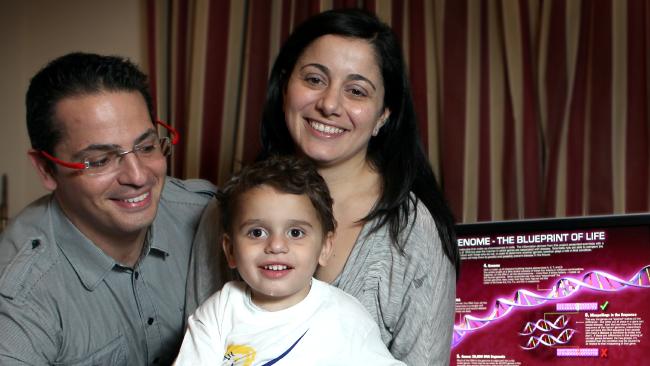 |
Pioneering a Genetic Cure
The Australian | July 2015 The human genome is a complex beast. It contains about six billion pairs of DNA building blocks, roughly one for every human on the planet. Cracking the Code is the story of one of those humans, little Massimo , and his father’s audacious plan to save him by hunting down a genetic flaw in the twisted labyrinth of his DNA.
|
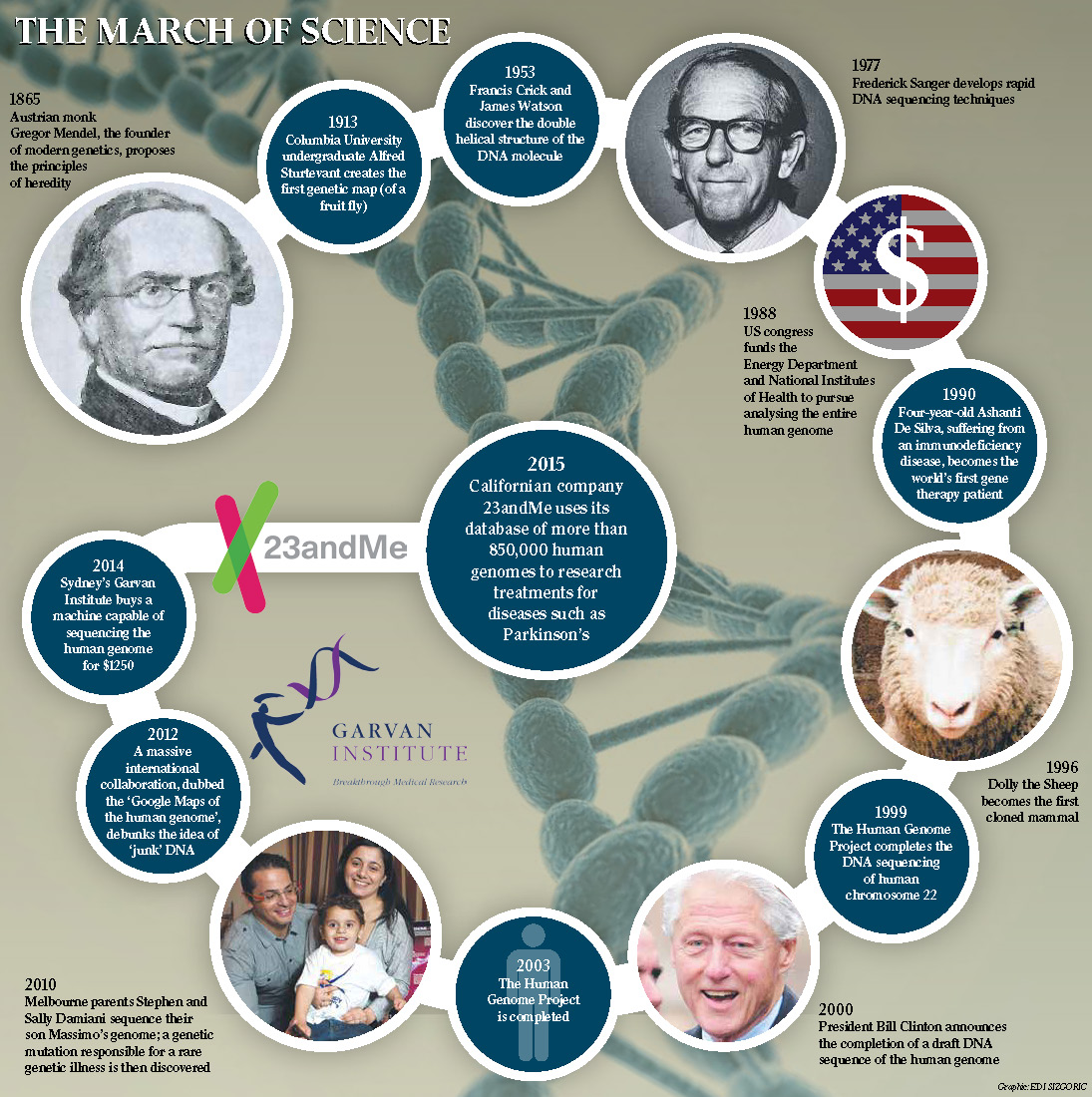 |
The March of Science
The Australian | May 2015 Melbourne parents Stephen and Sally Damiani sequence their son Massimo’s genome; a genetic mutation responsible for a rare genetic illness is then discovered. |
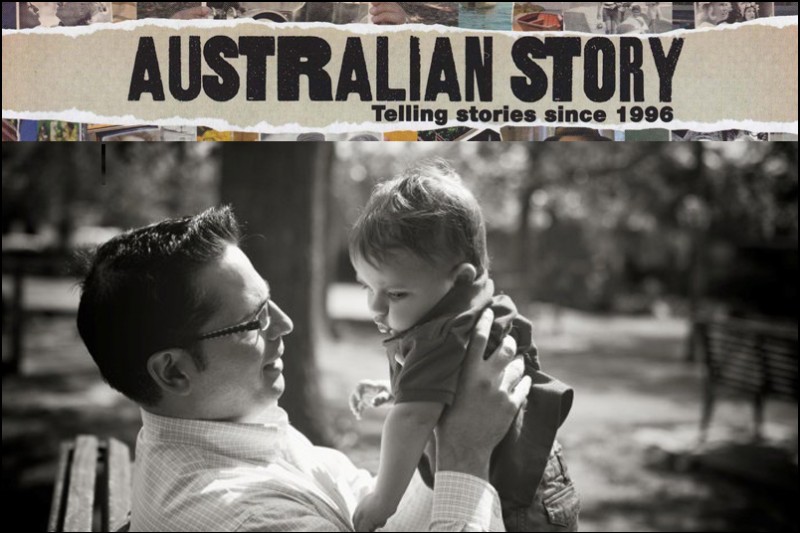 |
Cracking the Code
ABC Australian Story | October 2013 The Damiani family’s story has been described as a breathtaking example of how medicine can be transformed by the determination of ordinary people. Four years ago, Stephen and Sally’s baby son Massimo succumbed to a mystery disease. In the space of a few weeks, the toddler lost the ability to eat and crawl. The prognosis was bleak and the cause mystifying. Stephen, who has a background in construction economics and risk management, teamed up with a young geneticist to map the family’s genome in an attempt to discover the cause of his son’s illness. In the process, his seemingly impossible quest for answers has made a discovery that’s astonished the international medical community and has implications for us all. |
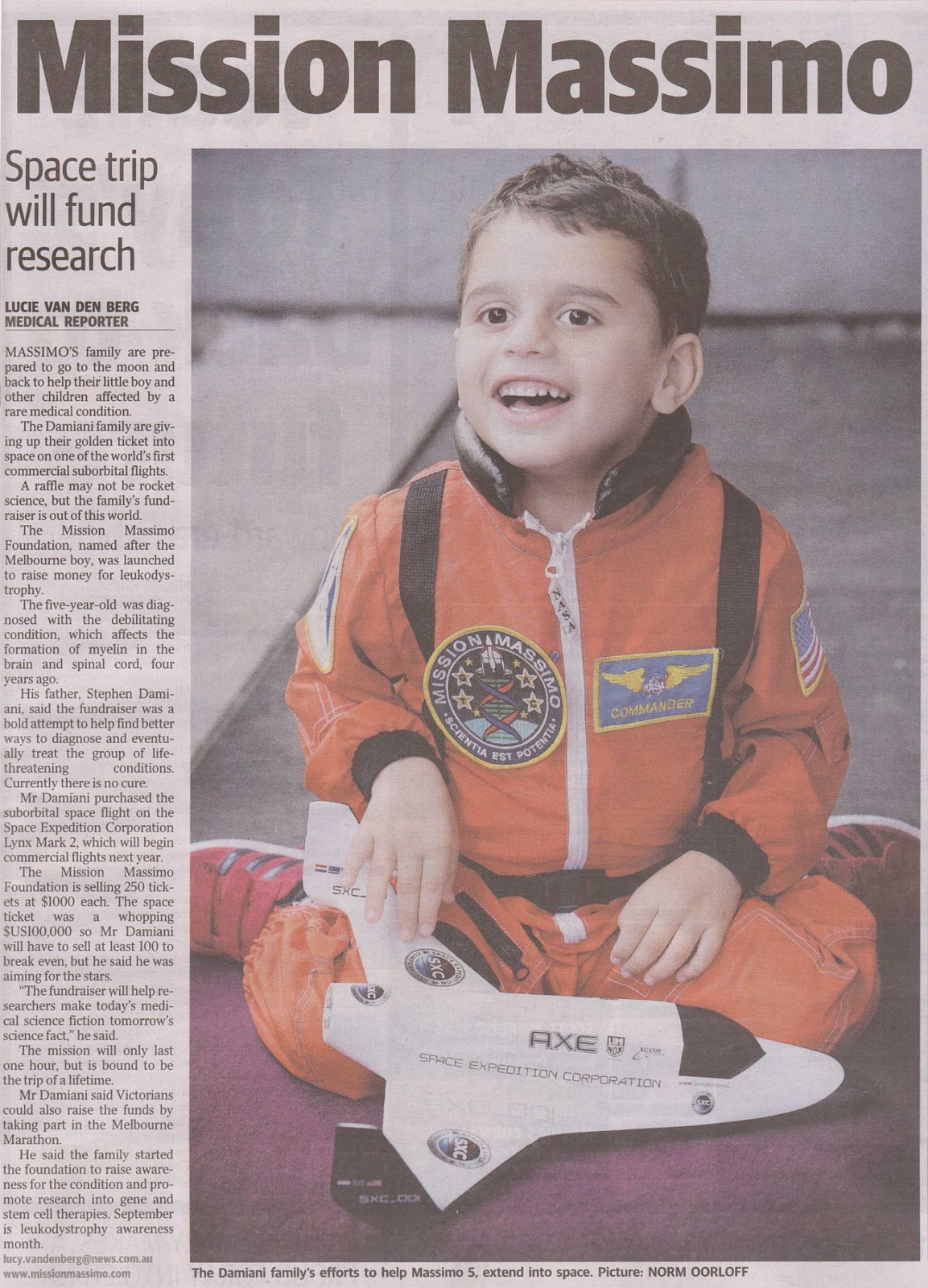 |
Mission Massimo
Herald Sun | September 2013 Massimo’s family are prepared to go to the moon and back to help their little boy and other children affected by a rare medical condition. The Damiani family are giving up their golden ticket into space on one of the world’s first commercial sub-orbital flights. |
 |
Decoding Massimo
The Australian | July 2013 The quest to find a diagnosis for one boy’s rare genetic disease led to a discovery “no less monumental than landing a man on the moon”. Click Here for full article. |
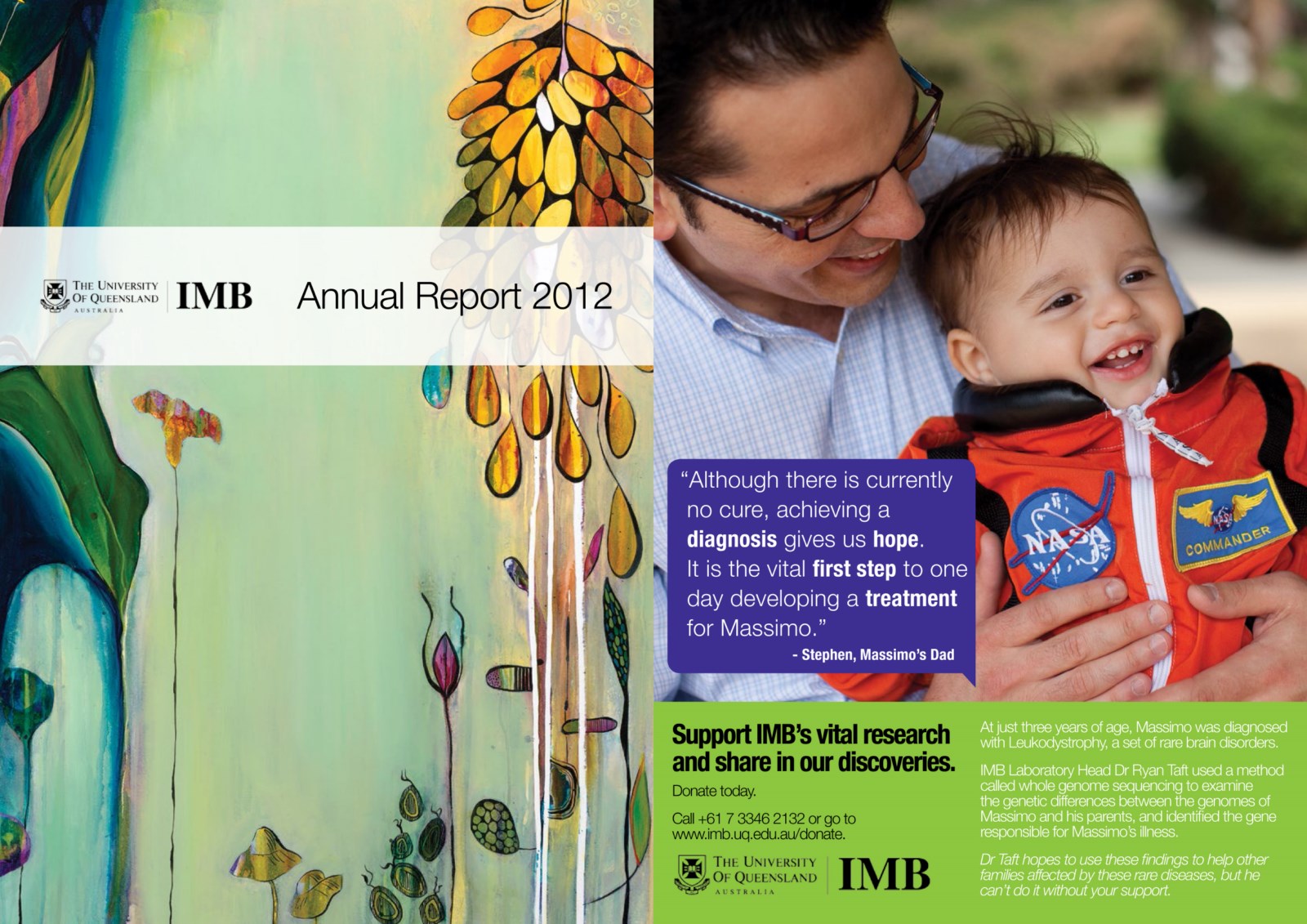 |
Institute of Molecular Biology – Annual Report
University of Queensland | June 2013 Our research seeks to answer pressing biological and medical questions using our fundamental knowledge of the genome and how it operates. For example, our work helps to directly identify and diagnose patients with rare genetic diseases, which currently affect more than 1.5 million Australians, with at least 400,000 of these patients fewer than 15 years of age. This research is also assisting with the development of tailored therapeutics and treatments for children diagnosed with rare diseases, including as leukodystrophies and Prader-Willi syndrome. |
| New Diseases Identified
University of Queensland | June 2013 Using the latest genetic technologies to investigate the genome. This research began with a little boy called Massimo. What was discovered was Massimo was suffering from a previously unclassified disease and already nine other children have been identified with the same disease. Hopefully this technology will go on to help design tailored therapeutics for individuals. |
|
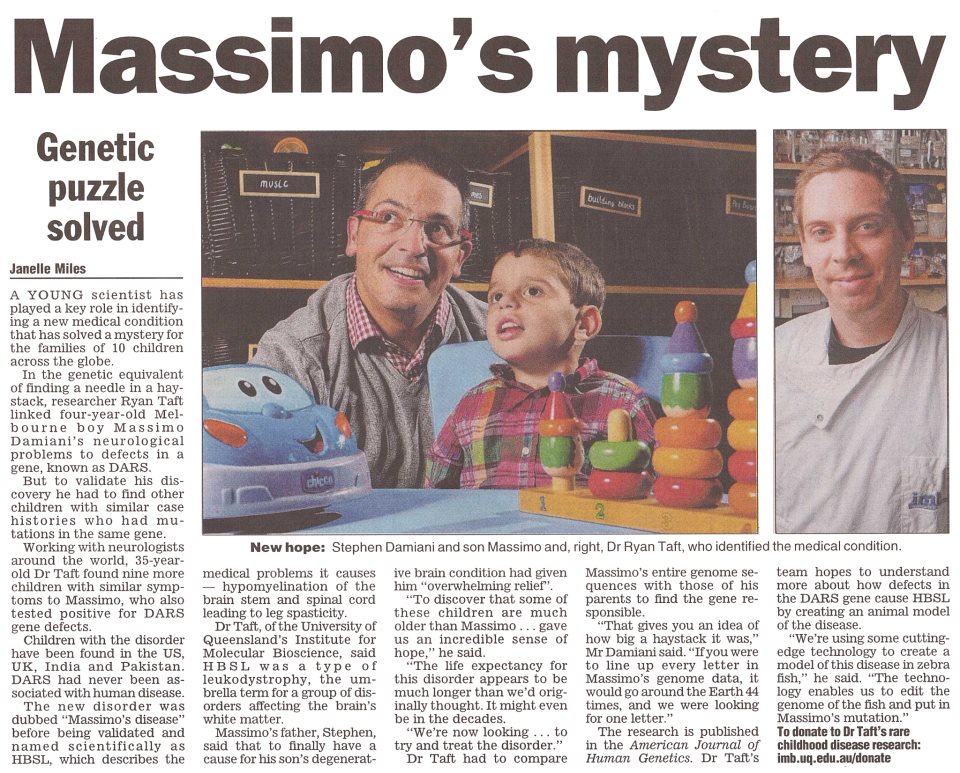 |
Massimo’s Mystery
Herald Sun | May 2013 A young scientist has played a key role in identifying a new medical condition that has solved a mystery that has solved a mystery for the families of ten children across the globe. In the genetic equivalent of finding a needle in a haystack four year old Melbourne boy Massimo has been diagnosed with a previously unclassified condition now known as Hypomyelination with brain stem and spinal cord involvement and leg spasticity (HBSL) caused by the DARS gene. |
| Miracle Within
Seven News | May 2013 Australian Researchers have made a ground breaking discovery to help a Melbourne toddler suffering an unknown brain disorder. They’ve identified a gene behind the disease and the discovery may lead to treatments for other rare genetic conditions. |
|
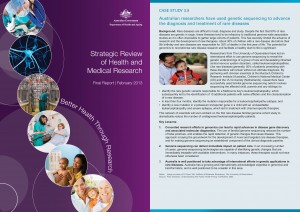 |
McKenzie Review of Health and Medical Research
February 2013 Australian Researchers have used genetic sequencing to advance the diagnosis and treatment of rare diseases. Researchers from the University of Queensland have led an international effort to use genome sequencing to reveal the genetic underpinnings of a group of rare and devastating inherited central nervous system disorders, called leukoencephalopathies. Like rare diseases, generally 50% of patients presenting with these disorders will remain without an ultimate diagnosis. By partnering with clinician scientists globally, researchers have successfully used familial genome sequencing to identify the rare genetic variants responsible for a Melbourne boy’s Leukoencephalopathy. |
| UQ Foundation Research Excellence Awards
University of Queensland | October 2012 Using genome sequencing to understand degenerative brain disorders in children. Leukodystrophies are a debilitating set of diseases that cause progressive loss of brain function and often lead to premature death. They are caused by a loss of myelin, which is an insulation layer around neurons, just like the plastic coating around copper wires. |
|
 |
Gene Discovery a Leap Beyond
Courier Mail | October 2012 A quest to help a young boy with a rare brain condition has led a Brisbane researcher to make a diagnosis that could go down in medical history.It’s one small step for a sick little boy, one giant leap for medical science. Brisbane researcher Ryan Taft believes he’s pinpointed the defective gene responsible for the degenerative brain disorder affecting 4 year old Melbourne boy Massimo Damiani. |
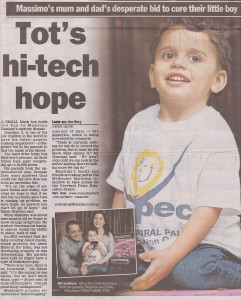 |
Tot’s Hi-Tech Hope
Herald Sun | September 2009 A small black box holds the key to Massimo Damiani’s mystery disease. Massimo, 3, is one of the few children in the world to have his entire genetic makeup sequenced – a desperate bid by his parents to find the cause of his illness. The hard drive holds this little boys genome, all three billion base pairs. His parents took the unprecedented step because they want answers that could one day save their son from an uncertain fate. |





Join Our Mission To End Childhood Leukodystrophies
Primary Sidebar Widget Area
This is the Primary Sidebar Widget Area. You can add content to this area by visiting your Widgets Panel and adding new widgets to this area.
Secondary Sidebar Widget Area
This is the Secondary Sidebar Widget Area. You can add content to this area by visiting your Widgets Panel and adding new widgets to this area.